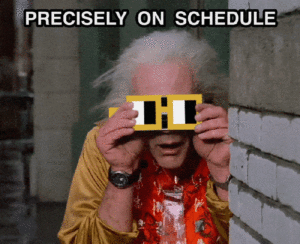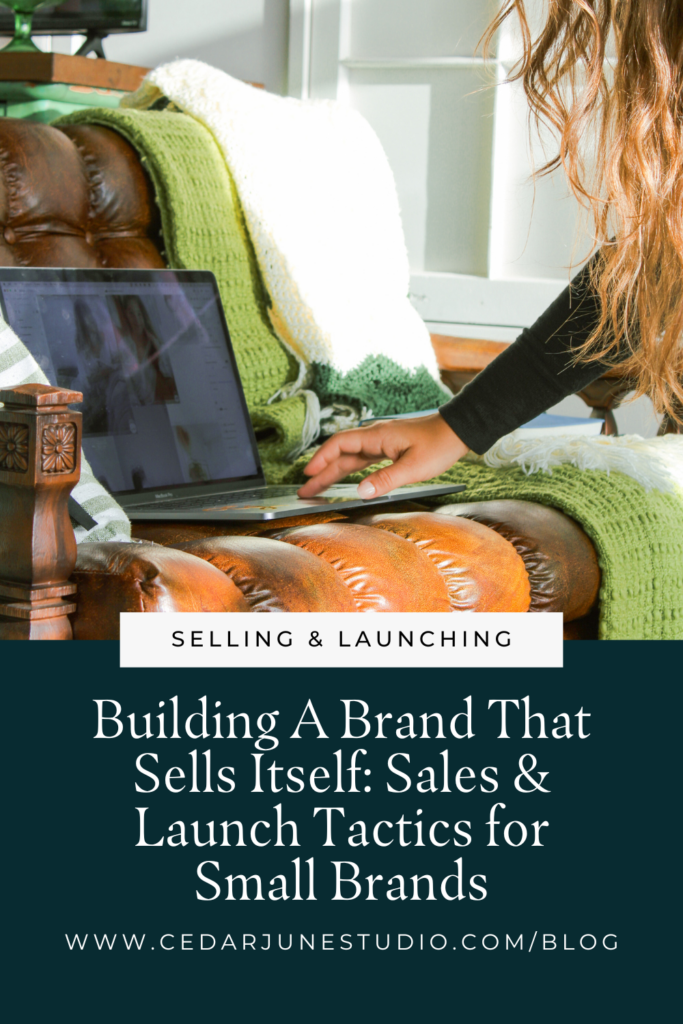THE cEDAR JUNE BLOG
Note To Self
Building A Brand That Sells Itself: Sales & Launch Tactics for Small Brands
Last I checked, you didn’t start a brand. Just to sit on it.
In fact, you’ve got big ideas and offers that you want to get people’s attention.
But – that’s wayyy easier said than done.
Whether you are launching or promoting a digital product, a free resource, course, workshop, membership, or offer – you’ve got be pretty strategic to make some noise.
Between my own brand and the brands I manage, I’ve been behind the scenes for a handful of launches this year, both big and small.
From a brand & website launch that created 100 subscribers & 20 waitlist members without even having a lead magnet.
To a course launch that was a year in the making & totally flopped (which happens more than the IG accounts you look up to online will probably admit).
We’re about to enter the last quarter of the year, the quarter when most of us (after a slow summer) are trying to lean in to hit our yearly income goals and make a splash in our industries.
So, how do you cut through the noise of the Holiday sales season and a million launches and actually make some sales yourself?
The success of your next offer is going to come down to 3 things.

Factor #1 Time:
Time is both the bff and the worst enemy of your sales cycle. There is a lot to consider when it comes to time. Starting now – you want to give yourself enough time to sell. One thing I have noticed a major shift in within the last couple of years is the length of people’s pre-launch periods. Remember the course launch I mentioned?
One of the fundamental things that prevented the launch’s success was the prelaunch period. The sooner you start talking about something, testing ideas, messaging, and getting beta testers, the better.
Start mentioning the offer or launch you are working on sooner rather than later. Talk to your audience about it and get their input, even when it is just an idea.
Create a waitlist & open that shit up way in advance.
The days of the 7-day open cart are over.
People need to be reminded about what you are offering more times than you think.
Just because you see an established brand in your space launching something overnight that seems like an overnight success doesn’t mean it is.
The brands having big launches have either:
A. Been talking about that offer for a long time and priming their audience in advance
B. Launched that offer before
C. Probably both ↑
The closer we get to the Holidays, the more time you need to allocate to your announcements and launch periods.
But it’s not just how much time you give your launch—its effectiveness will also depend on what your audience’s time looks like.
How busy is your audience when you launch? What do they really need at this point in their year/life? It might not be that they aren’t interested—it just might not be the right time.
This is where audience listening, testing, and launching offers more than once can come in handy. Just because they didn’t pull the trigger doesn’t mean they weren’t listening.
They might just:
- Be really busy right now
- Not have the budget (but would love to save up for what you have)
- Have a couple other offers or courses they are working through
- Or all of the above.

Factor #2 Clarity
The second thing that will affect whether or not you are making sales is Clarity.
You could do all of the above right, but even if people understand what you are talking about/selling, you still won’t see sales.
Your offer/service needs to be clear to your audience.
It’s probably already clear to you.
You know what you have to offer, the value, and why it is perfect for them.
But they don’t.
When it comes to selling successfully, you need to make sure it is clear
- What your offer is
- Exactly who it is for
- The problem that it solves
More importantly, you need to say all of ↑ that ↑ in words and phrases that your audience understands and resonates with.
This is yet another place where audience listening and understanding (plus your copywriting skills) are super important (way more important than the colors you use or the logo on your sales email).
You typically lose people’s interest when you sell with:
- Too much jargon. Industry-specific terminology that makes sense to you but just confuses your audience.
- There is too much fluff. You are using lots of descriptive, beautiful words that don’t carry any weight regarding the problem you solve (I’m looking at you, spiritual baddies). When it comes to forking over cash, they need to do what’s in it for them (and that it is for them in the first place).
- Too much you – not enough them. Too much “we” and not enough “you”. Talking about yourself in the third person (for example: “Catie is a great brand designer”) instead of “here’s how you know if i’m a good fit for you”. You create a disconnect when you are talking about yourself like a robot and not directly to the person you are trying to sell to.
What is the hook? What can you promise? Who is the one person for whom this offer is perfect?
These are the make-or-break moments that create the clarity that people need to buy from you.
Factor #3 Audience Temp

Last but certainly not least is Audience Temp.
The best way I can think of to explain this really shows my “eldest sister” side.
If you have ever given a baby a bath, you have checked the temp of the water first.
Maybe you had a cute little rubber ducky thermometer.
You’ve got to get the water warm enough – before you put the baby in the bath.
Your audience needs to be warm enough – before you launch something.
The time you have taken to discuss your offer and how clear people are about what you do are part of what warms them up. But it’s not all of it.
Remember that the website & brand launch I mentioned that got 100 newsletter subscribers & 20 waitlist members (while the site was still under construction). The success of that brand’s launch (because it was a brand new brand & site) 150% came down to audience temp.
The brand’s founder already had a community on Facebook & Instagram where she had regularly added value.
Her audience already trusted her and wanted to support her as soon as she announced her brand and offer, which resulted in many initial conversions.
If you have a cold audience, you need to be even more strategic about how you sell.
Having a cold audience means the people you’re trying to reach with your marketing or content are unfamiliar with your brand, products, or services. They haven’t had previous interactions with your business and aren’t aware of what you offer.
In the context of marketing and brand building, a cold audience typically:
- Has little to no prior knowledge of your brand
- Hasn’t engaged with your content before
- May not be aware of the problem your product or service solves
- Requires more nurturing and education before they’re ready to consider making a purchase
On the day-to-day, it probably looks like this:
- Creating content for your brand – but not getting much engagement
- Promoting your offers online – but not getting many conversions (sales, clicks, applications, subscribers).
There is a disconnect between what you are trying to do and how your audience is responding.
But that doesn’t mean you are SOL.
A cold audience is an opportunity for your brand.
When dealing with a cold audience, it’s important to focus on
- building awareness (aka. making people aware of who you are and what you do)
- Providing value (aka. offering meaningful content, insights, or solutions that benefit your audience). This could include:
- Sharing expert knowledge or tips
- Solving common problems or pain points
- Offering free resources or tools
- Providing entertainment or inspiration
Gradually warm them up to your brand before attempting to sell to them directly.
Q4 might not be the right time to sell (especially on social).
Q4 might be a better time to work on nurturing your audience, adding value, and engaging with new people online.
But let’s be real, you still need to make some money, right?
Here are some strategies that could be a good fit for your brand when you need to sell to an audience that is still warming up to you and your brand.
- Provide more context than you think they need, especially about your brand and story. Sharing your journey, values, and experiences can help create a connection when selling to a cold audience. This additional context educates your audience, builds trust, and makes your expertise more relatable. By weaving your personal brand story into your explanations, you’re giving potential customers a reason to invest in you, not just your product or service.
- Beta launch an offer to a small group of interested customers at a discounted price. This allows you to gather feedback, refine your offering, and create buzz around your product or service. It also gives the people already dying to work with you a chance to get in at a lower price, which can be especially appealing to a cold audience.
- Turn up the volume on your audience. Focus on ways to get their input. Start sharing your offers when they are still ideas, and note what people respond to and the exact words they use when engaging with your content. This approach helps you refine your ideas and creates a sense of involvement and anticipation among your audience. By actively seeking and incorporating their feedback, you’re building a product or service that resonates with their needs, increasing the likelihood of success when you do sell.
- Create an offer that appeals to the “lipstick effect.” This psychological phenomenon suggests that consumers are more likely to purchase small, affordable luxuries during economic downturns. This could be a low-priced product or service for your brand that allows clients to experience your expertise without a significant financial commitment.
If you are planning on launching or promoting an offer, digital product, or service during the Q4 selling season, here’s a cheat sheet of strategies to consider.
- Start planning early: Give yourself enough time to develop and test your launches in advance.
- Align your launches with what your audience really needs during this season of life & business.
- Test your offers, do beta launches, and re-launch offers more than once in the year.
- Refine your messaging and make it easy for people to self-select whether or not this “thing” is meant for them.
- Focus on creating high-quality content that aligns with your offer
- Leverage multiple content platforms to promote your offerings (not just IG).
- Incorporate storytelling from personal experiences and client transformations in your content.
- Focus on shifting perspectives and building connections rather than over-educating.
Here’s how I can help you create brand-specific strategies to help you sell:
- Book a 60-minute Strategy Session: This is a personalized one-on-one consultation to explore your brand, audience, and launch goals. We’ll then work together to develop tailored strategies and actionable steps to increase sales.
- Subscribe to my Newsletter: Each week, you’ll receive a down-to-earth newsletter that goes behind the brand and gives you the real talk you’re craving about why & how to build and market your brand online.

8/25/2024
Building A Brand That Sells Itself: Sales & Launch Tactics for Small Brands
social, inspo & sound →
subscribe
BLOG
RESOURCES
BACK TO TOP ↑
spam is so not on brand, unsubscribe at any time
CONTACT
ATTICA - NEW YORK | POWERED BY SHOWIT | SITE DESIGN BY CEDAR JUNE STUDIO
home
COMMENT LOVE